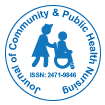Infection Control in Hospitals: Best Practices for Ensuring Patient Safety
Received: 03-May-2023 / Manuscript No. JCPHN-23-98092 / Editor assigned: 05-May-2023 / PreQC No. JCPHN-23-98092 (PQ) / Reviewed: 19-May-2023 / QC No. JCPHN-23-98092 / Revised: 22-May-2023 / Manuscript No. JCPHN-23-98092 (R) / Published Date: 29-May-2023 DOI: 10.4172/2471-9846.1000411
Abstract
Hospital-acquired infections (HAIs) are a significant public health concern, affecting millions of patients each year and leading to increased morbidity and mortality rates. These infections are caused by bacteria, viruses, fungi, and other microorganisms that can spread rapidly in hospital environments. To prevent the spread of HAIs, hospitals must have effective infection control policies and practices in place. In this article, we will discuss the best practices for infection control in hospitals and their impact on patient safety
Keywords
Hospital-acquired infections; Public health; Infections
Introduction
Hand hygiene is one of the most effective ways to prevent the spread of HAIs. Healthcare workers must wash their hands thoroughly before and after patient contact, after removing gloves, and after touching any equipment or surfaces in the patient's room. Hospitals should provide alcohol-based hand sanitizers in all patient care areas and promote the use of hand hygiene through education and awareness campaigns [1].
Material and Methods
Isolation precautions
Isolation precautions are essential for preventing the spread of infectious diseases in hospitals. Patients with suspected or confirmed infections should be placed in isolation rooms to prevent the transmission of the disease to other patients. Healthcare workers must wear appropriate personal protective equipment (PPE) when caring for patients in isolation rooms, including gloves, gowns, masks, and eye protection.
Environmental cleaning is another critical component of infection control in hospitals. Hospital staff should clean and disinfect patient rooms, equipment, and high-touch surfaces regularly to prevent the transmission of infectious diseases. Hospitals should have policies in place for the cleaning and disinfection of patient rooms and equipment, and staff should be trained on these policies [2, 3].
Medical equipment can also be a source of HAIs. Hospitals must have policies and procedures in place for the sterilization and disinfection of medical equipment, including surgical instruments and other reusable devices. Staff should be trained on the proper use of disinfectants and sterilization equipment and how to properly clean and maintain medical equipment [4, 5].
Vaccinations
Vaccinations are an essential tool in preventing the spread of infectious diseases in hospitals. Healthcare workers should receive vaccinations for common infectious diseases such as influenza, measles, mumps, rubella, and chickenpox. Hospitals should also encourage patients to receive vaccinations, especially for diseases such as influenza and pneumonia [6, 7].
Surveillance and reporting
Surveillance and reporting of infectious diseases are critical for identifying and preventing the spread of HAIs. Hospitals should have systems in place to track and report infections to local and state health departments. This information can be used to identify trends and patterns in infectious diseases and implement strategies to prevent future infections [8, 9].
Conclusion
Infection control in hospitals is essential for ensuring patient safety and preventing the spread of infectious diseases. Hand hygiene, isolation precautions, environmental cleaning, sterilization and disinfection of medical equipment, vaccinations, and surveillance and reporting are critical components of infection control in hospitals. Hospitals must have policies and procedures in place for these practices and provide education and training to healthcare workers to ensure compliance. By implementing best practices for infection control, hospitals can reduce the incidence of HAIs and promote patient safety [10].
References
- Perez JM (2007) 2: 535-536.
- Comotti M, Pina CD, Matarrese R, Rossi M (2004) . Chem Int Ed 43: 5812-5815.
- Pirmohamed T, Dowding JM, Singh S, Wasserman B, Heckert E (2010) Chem Commun 46: 2736-2738.
- Mu JS, Wang Y, Zhao M, Zhang L(2012) . Chem Commun 48: 2540-2542.
- Yin JF, Cao HQ, Lu YX (2012)
- Chen W, Chen J, Feng YB, Hong L, Chen QY, et al. (2012) . Analyst 137: 1706-1712.
- Wan Y, Qi P, Zhang, Wu JJ, Wang Y (2012) . Biosens Bioelectron 33: 69-74.
- André R, Natálio F, Humanes M, Leppin J, Heinze K, et al. (2011) Adv Funct Mater 21: 501-509.
- Daniels L, Fuchs G, Thauer RK, Zeikus JG (1977) J. Bact 132: 118-126.
- Cord-Ruwisch R, Lovley D R, Schink B (1998) .Appl Environ Microbiol64: 2232-2236.
, , Crossref
, , Crossref
, , Crossref
, , Crossref
, Crossref
, , Crossref
, , Crossref
, Crossref
,
, , Crossref
Citation: James A (2023) Infection Control in Hospitals: Best Practices for EnsuringPatient Safety. J Comm Pub Health Nursing, 9: 411. DOI: 10.4172/2471-9846.1000411
Copyright: © 2023 James A. This is an open-access article distributed under theterms of the Creative Commons Attribution License, which permits unrestricteduse, distribution, and reproduction in any medium, provided the original author andsource are credited.
Share This Article
Recommended Journals
Open 91桃色 Journals
Article Tools
Article Usage
- Total views: 1440
- [From(publication date): 0-2023 - May 04, 2025]
- Breakdown by view type
- HTML page views: 1199
- PDF downloads: 241
